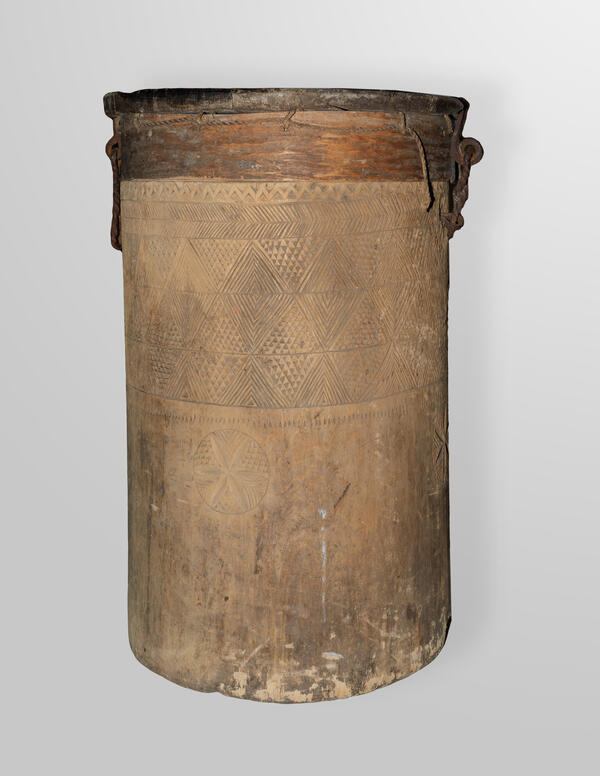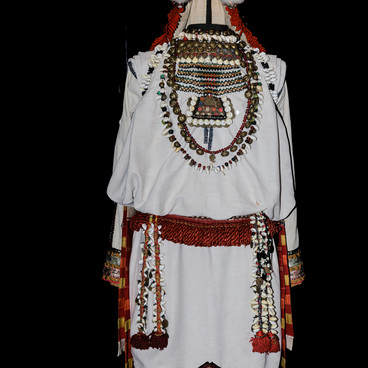The centuries-old history of each nation forms its own ideals of life, imbuing its vision of beauty in the objects it creates. The special coloring of embroidered national clothes, skillfully made headdresses, numerous temple, neck, pectoral and belt ornaments add distinctive and pronounced national features to the artistic culture of the Mordovian people. A chiseled wedding chest — par — was an obligatory implement of a Mordovian wedding. Those chests were of various sizes (their average height reached 80-90 centimeters), had a cylindrical form and a well fitted bottom. Massive cast-iron brackets for locks were hinged to them, and a tight lid was locked on them. It was usually ordered to craftsmen. The customer paid in grain or worked in the craftsman’s household for as many days as he made the par.
The upper half of the par was decorated with a three-edged incised geometric pattern with conventional images of human figures and tools. The decorative motifs of Mordovian wood-carving are rather diverse, and they are based on the simplest element — a triangle, which is the initial form for other, more complicated elements. A Mordovian carver succeeded in finding a harmonious combination of the background and the pattern, as well as in expressing his ideas about the universe, using simple woodworking techniques.
The decorative motifs had a deep sacred meaning. It was believed that a bride, together with her par and dowry, took away not only the memory of a carefree life in her parental home but also her future happiness as a woman. As an object of ritual purpose, the par was covered with appropriate writings, ancestral signs, and patterns bearing blessings for future family life. These drawings were supposed to promote happiness, well-being and fertility of a young family.
Among the ritual objects, the par chest has a special role. A bride kept canvas, towels, most valuable clothes, jewelry, and personal belongings for her future married life in the chest. Chiseled tubs, large measuring pots for flour and grain, everything that was also intended for household use, were not decorated in the same way as the chests, except for the application of the family or ancestral sign. This shows its distinctive feature and value.
The upper half of the par was decorated with a three-edged incised geometric pattern with conventional images of human figures and tools. The decorative motifs of Mordovian wood-carving are rather diverse, and they are based on the simplest element — a triangle, which is the initial form for other, more complicated elements. A Mordovian carver succeeded in finding a harmonious combination of the background and the pattern, as well as in expressing his ideas about the universe, using simple woodworking techniques.
The decorative motifs had a deep sacred meaning. It was believed that a bride, together with her par and dowry, took away not only the memory of a carefree life in her parental home but also her future happiness as a woman. As an object of ritual purpose, the par was covered with appropriate writings, ancestral signs, and patterns bearing blessings for future family life. These drawings were supposed to promote happiness, well-being and fertility of a young family.
Among the ritual objects, the par chest has a special role. A bride kept canvas, towels, most valuable clothes, jewelry, and personal belongings for her future married life in the chest. Chiseled tubs, large measuring pots for flour and grain, everything that was also intended for household use, were not decorated in the same way as the chests, except for the application of the family or ancestral sign. This shows its distinctive feature and value.




